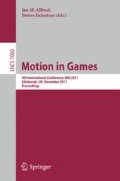Abstract
This paper is motivated by the objective of improving the realism of real-time simulated crowds by reducing short term collision avoidance through long term anticipation of pedestrian trajectories. For this aim, we choose to reuse outdoor pedestrian trajectories obtained with non-invasive means. This initial step is achieved by analyzing the recordings of multiple synchronized video cameras. In a second off-line stage, we fit as long as possible trajectory segments within predefined paths made of a succession of region goals. The concept of region goal is exploited to enforce the principle of “sufficient satisfaction”: it allows the pedestrians to relax the prescribed trajectory to the traversal of successive region goals. However, even if a fitted trajectory is modified due to collision avoidance, we are still able to make long-term trajectory anticipation and distribute the collision avoidance shift over a long distance.
Access this chapter
Tax calculation will be finalised at checkout
Purchases are for personal use only
Preview
Unable to display preview. Download preview PDF.
References
Berclaz, J., Fleuret, F., Türetken, E., Fua, P.: Multiple object tracking using k-shortest paths optimization. PAMI (February 2011)
Boulic, R.: Relaxed Steering Towards Oriented Region Goals. In: Egges, A., Kamphuis, A., Overmars, M. (eds.) MIG 2008. LNCS, vol. 5277, pp. 176–187. Springer, Heidelberg (2008)
Breitenstein, M.D., Reichlin, F., Leibe, B., Koller-Meier, E., Van Gool, L.: Online multiperson tracking-by-detection from a single, uncalibrated camera. IEEE Transactions on Pattern Analysis and Machine Intelligence 33, 1820–1833 (2011)
Brogan, D.C., Johnson, N.L.: Realistic human walking paths. In: CASA 2003, pp. 94–101 (2003)
Chenney, S.: Flow tiles. In: SCA 2004, pp. 233–242 (2004)
Courty, N., Corpetti, T.: Crowd motion capture. Computer Animation and Virtual Worlds 18, 361–370 (2007)
Fleuret, F., Berclaz, J., Lengagne, R., Fua, P.: Multi-camera people tracking with a probabilistic occupancy map. PAMI 30(2), 267–282 (2008)
Hillier, B., Penn, A., Hanson, J., Grajewski, T., Xu, J.: Natural movement: or, configuration and attraction in urban pedestrian movement. Environment and Planning B: Planning and Design 20(1), 29–66 (1993)
Kapadia, M., Singh, S., Hewlett, W., Faloutsos, P.: Egocentric affordance fields in pedestrian steering. In: I3D 2009, pp. 215–223. ACM (2009)
Karamouzas, I., Heil, P., van Beek, P., Overmars, M.H.: A Predictive Collision Avoidance Model for Pedestrian Simulation. In: Egges, A., Geraerts, R., Overmars, M. (eds.) MIG 2009. LNCS, vol. 5884, pp. 41–52. Springer, Heidelberg (2009)
Karamouzas, I., Overmars, M.: Simulating the local behaviour of small pedestrian groups. In: VRST 2010, pp. 183–190. ACM (2010)
Kwon, T., Lee, K.H., Lee, J., Takahashi, S.: Group motion editing. ACM Transactions on Graphics 27, 80:1–80:8 (2008)
Lee, K.H., Choi, M.G., Hong, Q., Lee, J.: Group behavior from video: a data-driven approach to crowd simulation. In: SCA 2007, pp. 109–118 (2007)
Lerner, A., Chrysanthou, Y., Lischinski, D.: Crowds by example. Computer Graphics Forum 26(3), 655–664 (2007)
Metoyer, R.A., Hodgins, J.K.: Reactive pedestrian path following from examples. In: CASA 2003. IEEE Computer Society (2003)
Oliver, N.M., Rosario, B., Pentland, A.P.: A bayesian computer vision system for modeling human interactions. PAMI 22(8), 831–843 (2000)
Park, M.J.: Guiding flows for controlling crowds. Vis. Comput. 26, 1383–1391 (2010)
Pettré, J.: Populate Your Game Scene. In: Egges, A., Kamphuis, A., Overmars, M. (eds.) MIG 2008. LNCS, vol. 5277, pp. 33–42. Springer, Heidelberg (2008)
Reitsma, P.S.A., Pollard, N.S.: Evaluating motion graphs for character animation. ACM Trans. Graph. 26 (October 2007)
Simon, H.A.: Rational choice and the structure of the environment. Psychological Review 63(2), 129–138 (1956)
Stylianou, S., Fyrillas, M.M., Chrysanthou, Y.: Scalable pedestrian simulation for virtual cities. In: VRST 2004, pp. 65–72. ACM (2004)
Treuille, A., Cooper, S., Popović, Z.: Continuum crowds. ACM Trans. Graph. 25, 1160–1168 (2006)
Tsai, R.Y.: A versatile cameras calibration technique for high accuracy 3d machine vision mtrology using off-the-shelf tv cameras and lenses. JRA 3(4), 323–344 (1987)
Tversky, A., Kahneman, D.: Judgment under uncertainty: Heuristics and biases. Science 185(4157), 1124–1131 (1974)
van den Akker, M., Geraerts, R., Hoogeveen, H., Prins, C.: Path planning for groups using column generation. In: Boulic, R., Chrysanthou, Y., Komura, T. (eds.) MIG 2010. LNCS, vol. 6459, pp. 94–105. Springer, Heidelberg (2010)
Yersin, B., Maïm, J., Morini, F., Thalmann, D.: Real-time crowd motion planning: Scalable avoidance and group behavior. Vis. Comput. 24, 859–870 (2008)
Yersin, B., Maïm, J., Pettré, J., Thalmann, D.: Crowd patches: populating large-scale virtual environments for real-time applications. In: I3D, pp. 207–214 (2009)
Zipf, G.: Human Behaviour and the Principle of Least-Effort. Addison-Wesley, Cambridge (1949)
Author information
Authors and Affiliations
Editor information
Editors and Affiliations
Rights and permissions
Copyright information
© 2011 Springer-Verlag Berlin Heidelberg
About this paper
Cite this paper
Ahn, J. et al. (2011). Long Term Real Trajectory Reuse through Region Goal Satisfaction. In: Allbeck, J.M., Faloutsos, P. (eds) Motion in Games. MIG 2011. Lecture Notes in Computer Science, vol 7060. Springer, Berlin, Heidelberg. https://doi.org/10.1007/978-3-642-25090-3_35
Download citation
DOI: https://doi.org/10.1007/978-3-642-25090-3_35
Publisher Name: Springer, Berlin, Heidelberg
Print ISBN: 978-3-642-25089-7
Online ISBN: 978-3-642-25090-3
eBook Packages: Computer ScienceComputer Science (R0)

